| | Greenhouse Gases | Dust | Pesticide Drift | Smoke | Odour
Greenhouse gases, blowing soil, pesticide drift, smoke and odour from cropping operations can reduce air quality.
Greenhouse Gases
Water vapour, carbon dioxide, methane, ozone, halocarbons (used in refrigerants), and nitrous oxide are the main greenhouse gases in the atmosphere. The trapping of heat by these gases controls the earth's surface temperature. Emissions from human activities are important additional sources of greenhouse gases. Increasing concentrations of these gases are believed to increase global warming. Global warming could result in such problems as more severe or extreme weather events like tornadoes, droughts and winter storms, more forest fires, and damage to water resources.
The main greenhouse gases emitted by the cropping industry are nitrous oxide and carbon dioxide. Nitrous oxide is emitted from soil through a biological process under low oxygen conditions (called anaerobic conditions). Thus waterlogging and any high nitrogen inputs (such as nitrogen fertilizer, legume crop residues, or manure) will increase nitrous oxide production.
Factors affecting emissions of nitrous oxide:
Emission of nitrous oxide is part of the cycling of nitrogen through the soil and air (Figure 2.8). The nitrogen cycle is affected by complex, interacting factors. In general, nitrous oxide emissions tend to increase:
- when the soil is waterlogged.
- when more nitrogen fertilizer or manure is applied to soils that are or become waterlogged.
- when nitrogen fertilizer is broadcast rather than banded.
- when nitrogen is applied long before the time the crop will use it (e.g. emissions from fall banding will be more than emissions from spring banding).
- when manure is left on the soil surface (rather than being incorporated into the soil or injected).
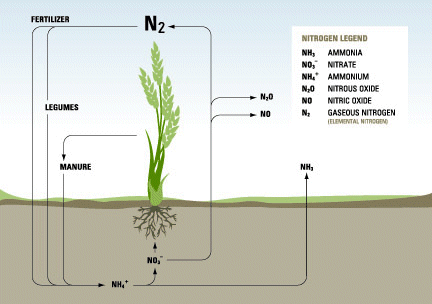
Figure 2.8. Nitrogen cycle in an agroecosystem
Adapted from: Figure 21 in Janzen, H.H., Desjardins, R.L., Asselin, J.M.R., and Grace, B. (eds). 1999. The Health of Our Air: Toward Sustainable Agriculture in Canada. Agriculture and Agri-Food Canada, Publication 1981/E. Reproduced with the permission of the Minister of Public Works and Government Services Canada, 2003.
Carbon dioxide emissions from crop production result mainly from decomposition of soil organic matter (Figure 2.9) and burning of fossil fuels. Cropping practices that increase soil organic matter levels remove carbon dioxide from the air and store the carbon in the soil. Carbon storage, also called carbon sequestration, reduces agriculture's greenhouse gas emissions.
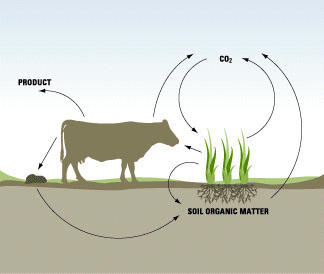
Figure 2.9. Carbon cycle in an agroecosystem
Adapted from: Figure 9 in Janzen, H.H., Desjardins, R.L., Asselin, J.M.R., and Grace, B. (eds). 1999. The Health of Our Air: Toward Sustainable Agriculture in Canada. Agriculture and Agri-Food Canada, Publication 1981/E. Reproduced with the permission of the Minister of Public Works and Government Services Canada, 2003.
Factors affecting emissions of carbon dioxide:
- Practices that increase accumulation of soil organic matter (see Soil Organic Matter) reduce carbon dioxide emissions.
- Frequent tillage increases carbon dioxide emissions by increasing the rate of decomposition of soil organic matter and increasing fuel usage.
- Burning of crop residues releases carbon dioxide into the atmosphere.
- Renewable energy sources, such as wind or solar power, do not emit carbon dioxide.
Dust
Along with being a social concern (see Reducing Nuisances for Neighbors), dust also creates environmental problems. It can cause respiratory problems for people and animals. It can reduce visibility on nearby roadways and may result in traffic accidents. Dust may contain diseases, seeds, pollen and plant tissue, as well as agrochemicals, such as pesticides. These materials can cause health problems and, in the case of pesticides, contaminate non-target areas. Dust from road travel can be a concern during such activities as harvesting or manure hauling.
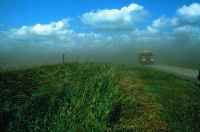
Wind erosion can reduce visibility.
Courtesy of DUC
Factors affecting dust levels:
- Areas at greater risk of wind erosion (see Wind Erosion) are at greater risk of contributing dust to the atmosphere.
- Dust from traffic on gravel roads increases with higher vehicle speeds, more vehicles, and lower moisture conditions.
Pesticide Drift
During pesticide application, spray droplets, mists or vapours may form. These airborne particles can drift and contaminate nearby land and water, and present a hazard to humans, animals and plants.
Spray drift onto water bodies can harm water quality and aquatic habitat. Drift toward farmsteads and other residences can cause human health problems or can damage gardens and trees. Some pesticides accumulate through bioconcentration and biomagnification, harming fish, birds and mammals higher in the food chain (Figure 2.7). Herbicide drift onto neighbouring fields can injure or kill sensitive crops in those fields. Insecticide drift can increase the risk of harming or killing non-target, beneficial insects.
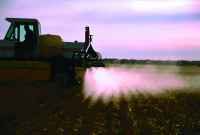 |
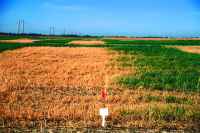 |
Herbicide drift can injure or kill crops on neighbouring fields.
Courtesy of Agriculture and Agri-Food Canada - Tom Wolf |
Factors affecting pesticide drift:
- Small spray droplets drift more easily than larger droplets.
- Wind speeds greater than 16 km/h create a high risk of spray drift.
- Air temperatures above 25°C and low relative humidity reduce droplet size through increased evaporation, and so increase the risk of spray drift.
- Higher boom heights increase the risk of spray drift. Boom height determines how much time droplets are exposed to air currents and other forces that reduce droplet size.
- Volatile pesticides can easily move into the air and be deposited elsewhere. Volatility is the ability of a substance to vaporize into the air. Higher spray pressure tends to increase spray drift.
- Spraying during a temperature inversion can increase the risk of spray drift (Figure 2.10).
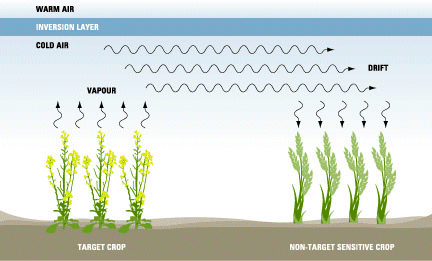
Figure 2.10. Temperature inversions can result in spray drift damage
Adapted from: Figure 14 in Ozkan, H. Erdal. 2000. Reducing Spray Drift. Bulletin 816-00. The Ohio State University Extension Bulletin.
Temperature inversions and pesticide spraying - Air temperature generally becomes cooler higher in the sky. However, during a temperature inversion, the air gets warmer with increased elevation. Temperature inversions occur during very calm conditions, usually in early morning or late evening. An inversion is occurring when it seems you can hear noises for miles or when smoke moves across the sky in a cloud rather than moving upwards and dispersing.
During an inversion, spray droplets can hang in the air as a concentrated cloud for some time after application. When winds pick up, the cloud can move to adjacent areas.
Smoke
Smoke contains soot (particles of carbon) that can cause respiratory problems. Smoke can also reduce visibility. If the fire gets out of control, it can endanger property and life, and there may be liability associated with fire and smoke hazards. Before burning, check local bylaws; many municipalities require permits for burning.
The two most common reasons for burning in a crop production system are to get rid of crop residues and to get rid of brush piles from cleared land. Burning of crop residues leaves the soil prone to erosion and all the problems that soil erosion generates (see Soil Erosion). As well, excess straw beyond that needed to protect the soil has many potential uses, including bedding and roughage for livestock.

Burning crop residues leaves soils prone to erosion.
Courtesy of Roger Bryan
Factors affecting smoke from burning:
- Higher wind speeds and drier conditions increase the risk of fires getting out of control.
- The material being burnt affects the amount of smoke and odour; green material is smokier.
- The degree of smoke hazard increases when smoke blows across roads or toward residences.
- Burning in the middle of the day reduces the degree of smoke hazard because air movement is usually better, resulting in better smoke dispersal.
Odour
Odours are primarily from ammonia and hydrogen sulphide. The main sources of ammonia and hydrogen sulphide in crop production are manure, fertilizers, crop residues and silage.
Factors affecting release of ammonia or hydrogen sulphide to the air:
- Ammonia is part of the cycling of nitrogen in the soil and air, which is affected by many factors. In general, ammonia emissions increase under wetter conditions, warmer conditions and when the soil is more alkaline.
- The release of ammonia tends to increase as more nitrogen fertilizer is applied and if the fertilizer is broadcast rather than incorporated or banded. The amount of ammonia released also depends on the type of fertilizer. Coated urea fertilizer releases nitrogen slowly, reducing the risk of nitrogen losses to the air.
- Incorporating surface-applied manure soon after application or injecting manure reduces ammonia and hydrogen sulphide emissions.
Back to Chapter 2 - Environmental Considerations |
|